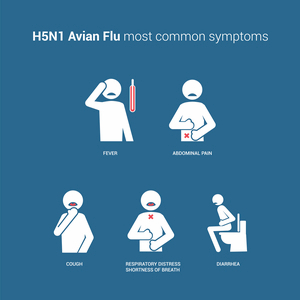With so much talk of influenza, coronaviruses, and the potential for a pandemic, 2020 has been a year when panic and misinformation has spread just as fast as any virus. People have been drawn to compare different diseases to the threat of Covid19, and some of the most common comparisons that are made are those of Covid19 and various types of influenza, including swine flu and bird flu, or avian flu. The reason for these comparisons is less to do with any similarities in the diseases themselves (although symptoms may be similar) and more to do with the fact that there have been many concerns about flu pandemics in our lifetimes. Outbreaks of new strains of flu are monitored very closely by experts in infectious diseases, and these are carefully studied to help us contain any spread of disease and learn how to prevent, treat and vaccinate against them. Bird flu is the common name that people give to avian influenza. As you might have guessed, this is a strain of flu, which primarily affects birds. However, just like other flu types, avian influenza strains have crossed over into the human population. This is what happened in the swine flu pandemic, but with pigs rather than birds.
How does Bird Flu spread?

Avian flu spreads from bird to bird when healthy birds come into contact with virus-infected secretions from the eyes, nostrils, and mouths or the waste of infected birds. The more virulent strains of the disease can spread extremely quickly and have a devastating effect on a bird population. But how do humans contract this disease if it is adapted to infecting birds? Humans can become infected with bird flu when they are in close contact with infected birds. For example, poultry farmers, those involved with slaughtering birds or preparing them for cooking by plucking, etc., could potentially contract it. The good news is that humans are not known to pass on avian flu to other humans. However, influenza viruses do adapt and change, so there is concern that this flu virus could mutate in such a way as to allow for human to human spread of the disease.
Types of Bird Flu

There is no one particular strain of avian flu, but rather a number of different strains. This is also true of human influenza; there are many different variations of the disease. Even what we call seasonal flu that spreads through human populations during the winter months each year is actually a number of different flu viruses. There are many avian flu subtypes that do not cross into the human population and only three strains that are known to have caused the death of a person. The most common of the avian flu strains is known as Influenza A (H5N1).
- H5N1 is the virus most often referred to when we talk about bird flu. This virus has been particularly damaging to bird populations in Africa, Asia, and Europe, with millions of birds killed by the disease. It is a particularly dangerous virus for humans, with a mortality rate somewhere around 60%. This is all very worrying, but again, the virus does not jump easily from birds to humans, and human to human transmission is extremely uncommon; in fact, while it is suspected that human to human transmission has occurred, it has not been confirmed that the disease has definitely ever spread from human to human.
Symptoms of Bird Flu
Bird flu symptoms typically happen very quickly. These symptoms might include:
- A fever/high temperature
- Body aches/muscle pain
- Coughing/chest pain
- Headaches
- Gastric symptoms such as stomach pain, vomiting, and diarrhea
- Irritated eyes/conjunctivitis
- Bleeding gums/nose

Treatment of Bird Flu
If a person thinks that they have contracted avian flu because they have been somewhere where there has been an outbreak and have been in contact with birds and are suffering from flu symptoms, it is vital that they get tested to check for the presence of the virus. This would involve a swab that would then be checked at a laboratory to look for the virus and identify the strain.
Bird flu is treated using antiviral medications. Patients suffering from the illness may be given a number of antiviral treatments to reduce the severity and the longevity of the illness. The symptoms may become more serious, and some patients require hospital treatment for acute respiratory distress or pneumonia. These are serious respiratory conditions that require more invasive treatment.
Avoiding Bird Flu
In order to reduce the risk of getting this type of flu, people are asked to take care when visiting a country that has had outbreaks of the disease. Simply avoiding contact with birds and poultry is key, including avoiding animal markets or farms. Good food hygiene (washing hands before and after handling food, especially raw meat) and ensuring food (including eggs) is cooked throughout is good practice.
The WHO (World Health Organization) states:
Influenza viruses, with the vast silent reservoir in aquatic birds, are impossible to eradicate. Zoonotic influenza infection in humans will continue to occur. To minimize public health risk, quality surveillance in both animal and human populations, thorough investigation of every human infection, and risk-based pandemic planning are essential.
Bird Flu is not a common illness in humans, and it is generally limited to those who are in close, prolonged contact with infected birds. However, it can be a serious condition, and experts are increasingly concerned that it could pose a larger threat to public health in the future if the virus changed to become better at infecting human populations. You can check out CNNs timeline of bird flu here.
